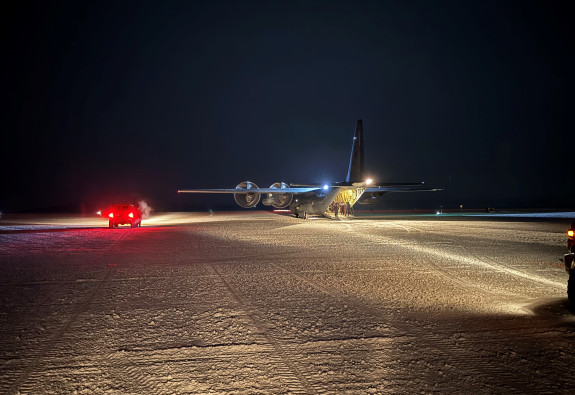Kiwi sailors thrive on US Navy flagship
23 May 2025
Unfortunately you are viewing this website on an outdated browser which does not support the necessary features for us to provide an adequate experience. Please switch to a modern browser such as latest version of Google Chrome, Mozilla Firefox, Apple Safari or Microsoft Edge.
Ngā mihi nui
Crew on a Royal New Zealand Air Force C-130J Hercules have carried out a challenging mid-winter medical evacuation from McMurdo Station in Antarctica.
The medical evacuation was requested by the United States' National Science Foundation because staff, based at the United States' McMurdo Station, were unable to receive the medical care they needed in Antarctica.
One person required urgent medical care and two others needing medical attention were also taken on the flight.
Air Component Commander Air Commodore Andy Scott said the extreme cold, changeable weather conditions plus landing on the ice in the dark make mid-winter flights to Antarctica one of the most challenging RNZAF air crews perform.
"The crew can only attempt the flight after detailed analysis of the weather and airfield state. The United States Antarctic Program Winter Team must physically create the runway before we can depart by ensuring the ice is groomed and suitable for landing.
"Although they determine it is safe, it's still an extremely challenging environment to fly in on Night Vision Goggles due to the extreme weather conditions, which are highly changeable at this time of year and makes accurate forecasting a challenge.
"This, coupled with there being no airfields available to divert to once the aircraft is past a certain point south adds to the risk, so these missions are not taken lightly.
"With the support of Antarctica New Zealand and United States' National Science Foundation staff in Antarctica, we have been able to complete the flight and the patients are now getting the medical treatment they need in Christchurch."
Photos taken by personnel during this week's RNZAF C-130J Hercules medical evacuation from Antarctica, which is in 24-hour darkness at this time of year.
The aircraft flew to Antarctica with New Zealand Defence Force medical personnel including a medical officer (doctor) on board to care for the patients on the flight back to Christchurch.
The aircraft had been pre-positioned from Auckland to Christchurch on Sunday afternoon, with the crew waiting for a window in the weather to complete the flight.
On Tuesday afternoon, the crew made the decision to fly, working through the night to complete the mission.
Once on the ice, the aircraft's engines are kept running to keep them warm while it is refuelled, known as "hot refuelling", before the aircraft returns to Christchurch.
Including the short time on the ice, the medical evacuation took about 19.5 hours to complete. The aircraft landed back in Christchurch this morning.

Credit Al Denovan Antarctica New Zealand